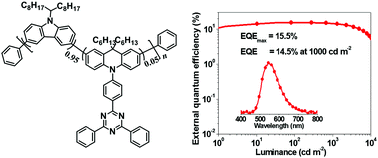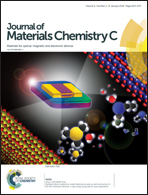Efficient non-doped yellow OLEDs based on thermally activated delayed fluorescence conjugated polymers with an acridine/carbazole donor backbone and triphenyltriazine acceptor pendant†
Abstract
Polymers with thermally activated delayed fluorescence (TADF) are very suitable and promising emitters for use in solution-processed organic light-emitting diodes (OLEDs). However, only a few efficient TADF polymers have been reported to date. In this work, a series of polymers with acridine/carbazole donor backbones and triphenyltriazine acceptor pendant are synthesized. The polymers show remarkable TADF due to the intrinsic twisted donor/acceptor structure derived from the copolymerization monomer and have a high photoluminescence quantum yield of up to 90%, in neat films, through management of the monomer ratios. Non-doped OLEDs based on the polymers display a yellow emission and achieve maximum external quantum and power efficiencies of up to 15.5% and 50.5 lm W−1. More importantly, the non-doped devices possess low turn-on and driving voltages of 2.53 V and 4.05 V (1000 cd m−2) with an extremely small efficiency roll-off of as low as 0.5%. Compared with doped devices, non-doped devices exhibit superior electroluminescent performances, with similar efficiencies but a lower efficiency roll-off and driving voltage, verifying that the designed conjugated polymers are superior emitters for non-doped TADF OLEDs by simple solution-processing.



 Please wait while we load your content...
Please wait while we load your content...